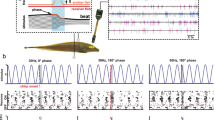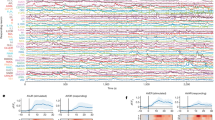Abstract
Stimulus-induced oscillations occur in visual1,2, olfactory3,4,5,6 and somatosensory7 systems. Several experimental2,3,5 and theoretical8,9,10,11,12,13 studies have shown how such oscillations can be generated by inhibitory connections between neurons. But the effects of realistic spatiotemporal sensory input on oscillatory network dynamics and the overall functional roles of such oscillations in sensory processing are poorly understood. Weakly electric fish must detect electric field modulations produced by both prey (spatially localized)14 and communication (spatially diffuse)15 signals. Here we show, through in vivo recordings, that sensory pyramidal neurons in these animals produce an oscillatory response to communication-like stimuli, but not to prey-like stimuli. On the basis of well-characterized circuitry16, we construct a network model of pyramidal neurons that predicts that diffuse delayed inhibitory feedback is required to achieve oscillatory behaviour only in response to communication-like stimuli. This prediction is experimentally verified by reversible blockade of feedback inhibition that removes oscillatory behaviour in the presence of communication-like stimuli. Our results show that a sensory system can use inhibitory feedback as a mechanism to ‘toggle’ between oscillatory and non-oscillatory firing states, each associated with a naturalistic stimulus.
This is a preview of subscription content, access via your institution
Access options
Subscribe to this journal
Receive 51 print issues and online access
$199.00 per year
only $3.90 per issue
Buy this article
- Purchase on Springer Link
- Instant access to full article PDF
Prices may be subject to local taxes which are calculated during checkout




Similar content being viewed by others
References
Gray, C. & Singer, W. Stimulus-specific neuronal oscillations in orientation columns of cat visual cortex. Proc. Natl Acad. Sci. USA 86, 1698–1702 (1989)
Sillito, A. M., Jones, H. E., Gerstein, G. L. & West, D. C. Feature-linked synchronization of thalamic relay cell firing induced by feedback from the visual cortex. Nature 369, 479–482 (1994)
MacLeod, K. & Laurent, G. Distinct mechanisms for synchronization and temporal patterning of odor-encoding neural assemblies. Science 274, 976–979 (1996)
Kashiwadani, H., Sasaki, Y. F., Uchida, N. & Kensaku, M. Synchronized oscillatory discharge of mitral/tufted cells with different molecular receptive ranges in the rabbit olfactory bulb. J. Neurophysiol. 82, 1786–1792 (1999)
Stopfer, M., Bhagavan, S., Smith, B. H. & Laurent, G. Impaired odour discrimination on desynchronization of odour-encoding neural assemblies. Nature 390, 70–74 (1997)
Friedrich, R. W. & Laurent, G. Dynamic optimization of odor representations by slow temporal patterning of mitral cell activity. Science 291, 889–894 (2001)
Ahissar, E. & Vaadia, E. Oscillatory activity of single units in a somatosensory cortex of an awake monkey and their possible role in texture analysis. Proc. Natl Acad. Sci. USA 87, 8935–8939 (1992)
Destexhe, A., Contreras, D. & Steriade, M. Mechanisms underlying the synchronization action of corticothalamic feedback through inhibition of thalamic relay cells. J. Neurophysiol. 79, 999–1016 (1998)
Bressloff, P. C. & Coombes, S. Dynamics of strongly coupled spiking neurons. Neural Comput. 12, 91–129 (2000)
Ernst, U., Pawelzik, K. & Geisel, T. Synchronization induced by temporal delays in pulse-coupled oscillators. Phys. Rev. Lett. 74, 1570–1573 (1995)
Wang, X.-J. & Rinzel, J. Spindle rhythmicity in the reticularis thalami nucleus: synchronization among mutually inhibitory neurons. Neuroscience 53, 899–904 (1993)
van Vreeswijk, C. & Hansel, D. Patterns of synchrony in neural networks with spike adaptation. Neural Comput. 13, 959–992 (2001)
Paulis, Q., Baker, N. B. & Olivier, E. Emergent oscillations in a realistic network: the role of inhibition and the effect of the spatiotemporal distribution of input. J. Comput. Neurosci. 6, 27–48 (1999)
Nelson, M. E. & MacIver, M. A. Prey capture in the weakly electric fish Apteronotus leptorhynchus: sensory acquisition strategies and electrosensory consequences. J. Exp. Biol. 202, 1195–1203 (1999)
Metzner, W. Neural circuitry for communication and jamming avoidance in gymnotiform electric fish. J. Exp. Biol. 202, 1365–1375 (1999)
Berman, N. J. & Maler, L. Neural architecture of the electrosensory lateral line lobe: adaptations for coincidence detection, a sensory searchlight and frequency-dependent adaptive filtering. J. Exp. Biol. 202, 1243–1253 (1999)
Wessel, R., Koch, C. & Gabbiani, F. Coding of time-varying electric field amplitude modulations in a wave-type electric fish. J. Neurophysiol. 75, 2280–2293 (1996)
Maler, L., Sas, E. K. & Rogers, J. The cytology of the posterior lateral line lobe of high frequency weakly electric fish (Gymnotoidei): differentiation and synaptic specificity in a simple cortex. J. Comp. Neurol. 195, 87–139 (1981)
Dayan, P. & Abbott, L. F. Theoretical Neuroscience (MIT Press, Cambridge, Massachusetts, 2001)
Bastian, J. & Nguyenkim, J. Dendritic modulation of burst-like firing in sensory neurons. J. Neurophysiol. 85, 10–22 (2001)
Maler, L. & Mugnaini, E. Correlating γ-aminobutyric acidergic circuits and sensory function in the electrosensory lateral line lobe of a gymnotiform fish. J. Comp. Neurol. 345, 224–252 (1994)
Berman, N. J., Plant, J., Turner, R. & Maler, L. Excitatory amino acid transmission at a feedback pathway in the electrosensory system. J. Neurophysiol. 78, 1869–1881 (1997)
Berman, N. J. & Maler, L. Interaction of GABAB-mediated inhibition with voltage-gated currents of pyramidal cells: computational mechanism of a sensory searchlight. J. Neurophysiol. 80, 3197–3213 (1998)
Glass, L. & Mackey, M. C. From Clocks to Chaos (Princeton Univ. Press, Princeton, New Jersey, 1988)
Doiron, B., Laing, C., Longtin, A. & Maler, L. Ghostbursting: a novel neuronal burst mechanism. J. Comput. Neurosci. 12, 5–25 (2002)
Lemon, N. & Turner, R. W. Conditional spike backpropagation generates burst discharge in a sensory neuron. J. Neurophysiol. 84, 1519–1530 (2000)
Bastian, J., Chacron, M. J. & Maler, L. Receptive field organization determines pyramidal cell stimulus encoding capability and spatial stimulus selectivity. J. Neurosci. 22, 4577–4590 (2002)
Gabbiani, F., Metzner, W., Wessel, R. & Koch, C. From stimulus encoding to feature extraction in weakly electric fish. Nature 384, 564–567 (1996)
Contreras, D., Destexhe, A., Sejnowski, T. J. & Steriade, M. Control of spatiotemporal coherence of a thalamic oscillation by corticothalamic feedback. Science 274, 771–774 (1996)
Kloeden, P. E. & Platen, E. Numerical Solutions to Stochastic Differential Equations (Springer, Berlin, 1992)
Acknowledgements
We thank J. Lewis, C. Laing, R. W. Turner and M. Higley for reading the manuscript. Funding was provided by the National Science and Engineering Research Council (B.D., M.J.C., A.L.), the Canadian Institutes of Health Research (A.L., L.M.) and the National Institutes of Health (J.B.).
Author information
Authors and Affiliations
Corresponding author
Ethics declarations
Competing interests
The authors declare that they have no competing financial interests.
Supplementary information
Rights and permissions
About this article
Cite this article
Doiron, B., Chacron, M., Maler, L. et al. Inhibitory feedback required for network oscillatory responses to communication but not prey stimuli. Nature 421, 539–543 (2003). https://doi.org/10.1038/nature01360
Received:
Accepted:
Issue Date:
DOI: https://doi.org/10.1038/nature01360
This article is cited by
-
Variable synaptic strengths controls the firing rate distribution in feedforward neural networks
Journal of Computational Neuroscience (2018)
-
Adaptation to second order stimulus features by electrosensory neurons causes ambiguity
Scientific Reports (2016)
-
Effect of inhibitory feedback on correlated firing of spiking neural network
Cognitive Neurodynamics (2013)
-
Responses of recurrent nets of asymmetric ON and OFF cells
Journal of Biological Physics (2011)
-
Nonrenewal spike train statistics: causes and functional consequences on neural coding
Experimental Brain Research (2011)
Comments
By submitting a comment you agree to abide by our Terms and Community Guidelines. If you find something abusive or that does not comply with our terms or guidelines please flag it as inappropriate.



